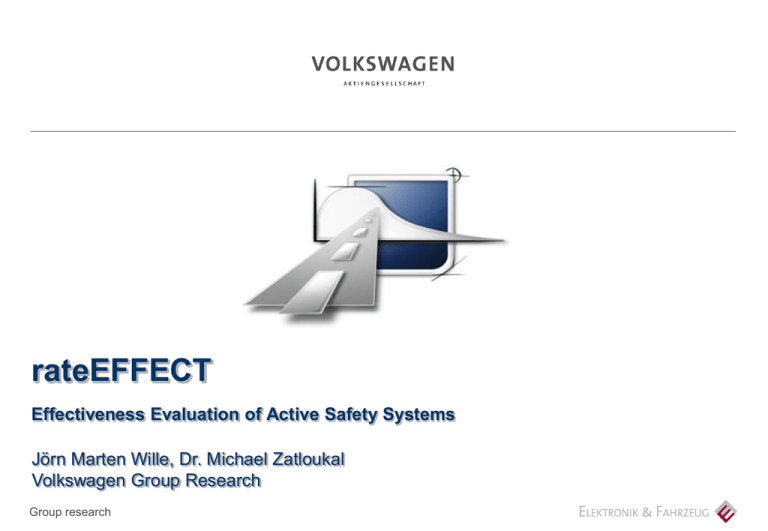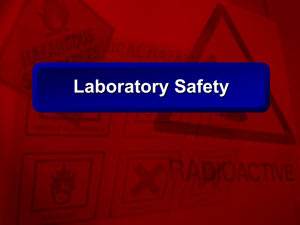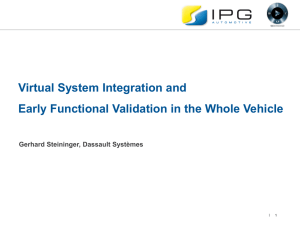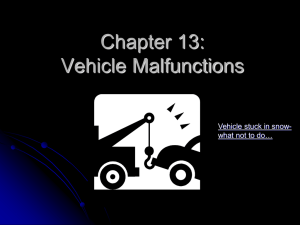rate_effect
advertisement

rateEFFECT Effectiveness Evaluation of Active Safety Systems Jörn Marten Wille, Dr. Michael Zatloukal Volkswagen Group Research Group research rateEFFECT: Effectiveness Evaluation of Active Safety Systems 1 Intention and Motivation 2 Evaluation Approach - Introduction to rateEFFECT 3 Evaluation of Crash Avoiding Systems 4 Database – GIDAS-preCrashMatrix 5 Opportunities for US Pre-crash Data Group research Slide 2 rateEFFECT: Effectiveness Evaluation of Active Safety Systems 1 Intention and Motivation 2 Evaluation Approach - Introduction to rateEFFECT 3 Evaluation of Crash Avoiding Systems 4 Database – GIDAS-preCrashMatrix 5 Opportunities for an US Pre-crash Data Group research Slide 3 Intention and Motivation A B Which active safety systems should be developed to maximize safety benefit in real traffic accidents? What is the effectiveness of a specific active safety system in the real world? How many casualties could be avoided by such a system? Group research Slide 4 Status quo Forecast with System Casualties / Fatalities Rating Process System configuration Algorithm Sensor Driver model Injury risk function rateEFFECT 3 Actuator PC-Crash PC-Crash PC-Crash 4 100% 100% 200 70% 50% 60% 40%-50% 50% 30%-40% 70 60 50 40 30 20 150 Anzahl Fälle 20%-30% 40% 40% MAIS2+ 50%-60% 60% 0% 100 10%-20% 30% 0%-10% 20% 50 10% Geschwindigkeitsänderung dv in km/h 0% 10 0 0 5 10 15 20 25 30 35 40 45 55 60 65 70 75 80 Annäherungsgeschwindigkeit in km/h 2 Target population 5 Effectiveness evaluation 1830 Berechnete Unfälle (Wirkfeld) 1 Beeinflusste Unfälle 8% 739 1091 4% addressable accidents 1 Initial accident world 2 Target population – case selection 3 FAS&IS system 4 Modified accidents (∆v, collision angle etc.) 5 Lowered injury severity 6 Translation into a rating Group research 50 0 Real world accidents (Germany) 6 Optional rating Slide 5 tat. rel. Häufigkeit 60%-70% 10% Current level of safety 70%-80% 70% 20% GIDAS PreCrash-Matrix Konfidenzband 80%-90% 80% 80% 30% Conceptual, model or real algorithms 250 90%-100% 90% 90% Nicht beeinflusste Unfälle Effectiveness vs. Target Population – Need for Simulation Questions the target population alone cannot answer: How does a specific system design influence its performance? Is driver reaction relevant for this scenario? What is the performance of a warning system compared to an AEB? Group research Slide 6 The Effectiveness Analysis is based on the In-the-LoopMethod System Description Corresponds to the behavior of real vehicle components System Modelling Sensor 1 Classical simulator approach: Interaction in every integration step Sensor 2 Algorithm 1 Sensor 3 Algorithm 2 Warning 1 Based on PC-Crash (vehicle dynamics and scenery) Modelling of arbitrary systems possible (including continuous feedback control systems) Driver model 1 Actuator 1 Integration of arbitrary algorithms and complex driver models PC-Crash Adaption of the database to current safety level Group research Actuator 2 Slide 7 FAS&IS-system Driver Interaction rateEFFECT Analysis with Different Levels of Detail 1 n 2 Target population Potentially addressable accidents Best-case-analysis Target population Simplified system Real system rateEFFECT analysis of a simplified system Maximum of the achievable effect of a modelled System rateEFFECT analysis of a real approximated system Approximated effect of a real systems Effectiveness evaluation Effectiveness evaluation 1830 Berechnete Unfälle (Wirkfeld) 1830 Berechnete Unfälle (Wirkfeld) Beeinflusste Unfälle Beeinflusste Unfälle 8% 4% Group research 8% 739 1091 Nicht beeinflusste Unfälle 739 4% Slide 8 1091 Nicht beeinflusste Unfälle rateEFFECT Analysis of a Fictitious Emergency Brake System System description: Detectable: PreCrash system with distance sensors to avoid or mitigate frontal impacts Not detectable: Velocity range: 0 – 200 km/h Sensor properties: System action: Three step braking up to full emergency brake in case an impact is about to happen deceleration a Range 80m Opening angle : 45° Group research Slide 9 time t Accidents altered by system Accidents not altered by system Performance figures Ø dV original accident data (1830): 15,64 m/s Ø dV altered accidents (1091): 13,82 m/s Ø dV reduction altered accidents (1091): 7,07 m/s Group research Casualties per year Number of accidents simulated (target population) Injury risk (MAIS2+) Effectiveness Evaluation via Reduction of Injury Risk (MAIS2+) Vehicle - vehicle 0,72% 5.4% Adjusted to meet current safety level System effectiveness Difference between reference and estimated scenario -352 Without System Without system: 2638 Forecast 2286 Severely injured+ Slide 10 Target population Adjusted to meet current safety level System Difference between reference and estimated scenario Summary of the Evaluation: Altered Accidents 1 Basic Configuration: Emergency Brake System 2 BAS + Autonomous Brake 3 “…” + Warning + Driver‘s Reaction 4 “…” + always detect stationary vehicles Group research Slide 11 Summary of the Evaluation: System Effectiveness Injury risk (MAIS2+) 0,34% 5.4% 5.06% ≙ 6.3 % of Target Population 3 “…” + Warning + Driver‘s Reaction Injury risk (MAIS2+) 2 BAS + Autonomous Brake 0,81% 5.4% Group research 4.59% ≙ 0,68% 5.4% 4.72% ≙ 12.6 % of Target Population 4 “…” + always detect stationary vehicles Injury risk (MAIS2+) Injury risk (MAIS2+) 1 Basic Configuration: Emergency Brake System 15 % of Target Population Slide 12 1,9% 5.4% 4.59% ≙ 35.2 % of Target Population Backup Group research Slide 13 rateEFFECT: Effectiveness Evaluation of Active Safety Systems 1 Intention and Motivation 2 Evaluation Approach - Introduction to rateEFFECT 3 Evaluation of Crash Avoiding Systems 4 Database – GIDAS-preCrashMatrix 5 Opportunities for US Pre-crash Data Group research Slide 14 Integrating Real World Tests System configuration Algorithm Sensor Driver model Injury risk function rateEFFECT 3 Actuator PC-Crash PC-Crash PC-Crash 4 100% 100% 70% 50% 40% 70 60 50 40 30 20 Test results 3 FAS&IS system 4 Modified accidents (∆v, collision angle etc.) 5 Lowered injury severity 6 Translation into a rating Group research 30%-40% 150 Anzahl Fälle 20%-30% 100 10%-20% 30% 0%-10% 20% 50 10% Geschwindigkeitsänderung dv in km/h 0% 10 0 0 5 10 15 20 25 30 35 40 45 50 55 60 65 70 75 80 Annäherungsgeschwindigkeit in km/h 5 Effectiveness evaluation 1830 Berechnete Unfälle (Wirkfeld) Beeinflusste Unfälle 739 1091 4% 2 40%-50% 50% 0 8% Translation into tests 60% 40% 0% Real world test 6 Optional rating Slide 15 tat. rel. Häufigkeit MAIS2+ 50%-60% 60% 2 1 200 60%-70% 10% 1 70%-80% 70% 20% Real world accidents Konfidenzband 80%-90% 80% 80% 30% Conceptual, model or real algorithms 250 90%-100% 90% 90% Nicht beeinflusste Unfälle rateEFFECT Analysis of a Fictitious Emergency Brake System System description: Detectable: PreCrash system with distance sensor to avoid or mitigate frontal impacts Not detectable: Velocity range: 0 – 200 km/h Detects stationary vehicles at v < 30 km/h Sensor properties: Three step braking up to full emergency brake in case an impact is about to happen BAS to full brake in case driver is braking Opening angle: 60° y System action: Deceleration [m/s²] Range: 100m x dX Time [s] Partial Brake 1 Partial Brake 2 - 1g Full Brake Group research Slide 16 Five Steps for the Target Population 1 Target population study (U.S.) 2 Accident level 3 Target population on person level 4 Comparison with target population in Germany 5 Target population in Germany (used for effectiveness calculation) Group research Slide 17 Target Population Forward Collision Warning 25% 20% 23% 15% 10% 11% 5% 2% 0% All crashes Group research Nonfatal injury crashes Slide 18 Fatal crashes Source: Farmer 2008, Crash Avoidance Potential of Five Vehicle Technologies Target Population (Persons) Front to Rear / Car to Car in U.S. 90% 80% 70% 60% 50% Not injured+ 40% Minor injuries+ Severely injured+ 30% 20% 10% 0% First harmful event: collision with vehicle Group research + Two vehicles involved, no twowheelers + Front to rear collision Slide 19 + No avoidance maneuver Target Population (Persons) Front to Rear / Car to Car 30% 25% 24% 20% U.S. Not injured+ Minor injuries+ 15% Severely injured+ Fatally injured 10% 9% Germany 7% 5% 2% 0% Not injured+ Group research Severely injured+ 5.4% Minor injuries+ Severely injured+ Slide 20 Fatally injured Target Population Front to Rear / Car to Car Germany Target population severely injured (MAIS2+) persons for Germany 80% 70% 70,8% 60% 50% 49,2% 40% 39,6% 1830 simulated accidents 30% City-AEB: Stationary targets only below 30 km/h ego velocity 20% 19,0% 17,6% 10% 5,4% 0% Vehicle involved + vehicle frontal deformation Group research + no skidding, visibility obstruction, Kickdown + opponent vehicle Slide 21 + opponent velocity + front - rear collision 1,9% + velocity restriction for stationary targets Four Different Variations of the Safety System 1 Basic Configuration: Brake Assist (BAS) 2 “…” + Autonomous Brake BAS: If driver is braking above 6 m/s² in the original accident, this is increased to maximum braking Three braking levels based on criticality Driver braking in original accident: increased to maximum braking System can detect stationary vehicles up to ego velocity of 30 km/h (city AEB) 3 “…” + Warning + Driver‘s Reaction Three braking levels based on criticality Autonomous braking triggers warning function, driver reacts with 1s reaction time 4 “…” + always detect stationary vehicles System can detect stationary vehicles regardless of ego vehicle velocity Driver reaction is always braking. This is increased to maximum braking by the system Group research Slide 22 Effectiveness Evaluation via Reduction of Injury Risk (MAIS2+) Performance figures Ø dV original accident data (1830): 15,64 m/s Ø dV altered accidents (961): 13,82 m/s Ø dV reduction altered accidents (961): 7,07 m/s Casualties per year Injury risk (MAIS2+) 1830 accidents simulated (target population) Vehicle - vehicle 0,81% 5.4% Target population Adjusted to meet current safety level System effectiveness Difference between reference and estimated scenario -396 Without System Without system: 2638 Forecast 2242 Severely injured+ Adjusted to meet current safety level System Difference between reference and estimated scenario Configuration 3: Brake Assist + Autonomous Brake + Warning + Driver‘s Reaction Group research Slide 23 Summary of the Evaluation: Altered Accidents 1 Basic Configuration: Emergency Brake System 2 BAS + Autonomous Brake 3 “…” + Warning + Driver‘s Reaction 4 “…” + always detect stationary vehicles Group research Slide 24 Summary of the Evaluation: System Effectiveness Injury risk (MAIS2+) 0,34% 5.4% 5.06% ≙ 6.3 % of Target Population 3 “…” + Warning + Driver‘s Reaction Injury risk (MAIS2+) 2 BAS + Autonomous Brake 0,81% 5.4% Group research 4.59% ≙ 0,68% 5.4% 4.72% ≙ 12.6 % of Target Population 4 “…” + always detect stationary vehicles Injury risk (MAIS2+) Injury risk (MAIS2+) 1 Basic Configuration: Emergency Brake System 15 % of Target Population Slide 25 1,9% 5.4% 4.59% ≙ 35.2 % of Target Population Summary of the Evaluation: Injuries and Fatalities 2 BAS + Autonomous Brake 1 Brake Assist (BAS) -166 -166 -166 Without System 2638 Adjusted to meet current safety level 2638 2472 2472 2306 System effectiveness Difference between reference and estimated scenario Casualties 3 “…” + Warning + Driver‘s Reaction -166 2638 2472 1 2 4 “…” + always detect stationary vehicles -166 -166 -166 -64 2638 2306 2242 2472 2306 -64 -532 2242 1710 1 Group research 2 3 1 Slide 26 2 3 4 rateEFFECT Analysis of the Potential of a Fictitious Pedestrian Protection System System description: Detectable: PreCrash system with distance sensor to avoid or mitigate frontal impacts with pedestrians Not detectable: Velocity range: 0 – 60 km/h Reacts only when pedestrian enters the road System action: Sensor properties: Driver braking in original accident is increased to max braking y Deceleration [m/s²] Opening angle: 40° Emergency braking with 0.8g Range: 40m x dX Group research Slide 27 Time [s] - 1g 0.8g brake Severely injured (MAIS2+) persons Target population vehicle-pedestrian accidents Germany Accidents involving pedestrians Group research Passenger car – pedestrian accidents Slide 28 Accidents altered by system 330 523 Accidents not altered by system Performance figures Ø Vc original accident data: 30.35 km/h Ø Vc altered accidents (961): 24.13 km/h Casualties per year 853 accidents (target population) Injury risk (MAIS2+) Comparison with Pedestrian Protection Vehicle - vehicle 2.1% 12.6% Slide 29 Adjusted to meet current safety level System effectiveness Difference between reference and estimated scenario -1026 Without System Without system: 6154 Forecast 5128 Severely injured+ Group research Target population Adjusted to meet current safety level System Difference between reference and estimated scenario Evaluation Conclusions System effectiveness strongly depends on system design Based on the simulation vehicle-to-vehicle forward collision warning / mitigating systems would benefit if stationary targets could be detected at all ego vehicle speeds (sensor limiations, detection of gullys etc.) Vechicle-to-vehicle forward collision systems address scenarios where passive safety works to the fullest Technical specifications which are not regarded here may lower system effectiveness Property damage can currently not be assessed Question: What is the effectiveness in the U.S.? Group research Slide 30 rateEFFECT: Effectiveness Evaluation of Active Safety Systems 1 Intention and Motivation 2 Evaluation Approach - Introduction to rateEFFECT 3 Evaluation of Crash Avoiding Systems 4 Database – GIDAS-preCrashMatrix 5 Opportunities for US Pre-crash Data Group research Slide 31 Projecting VW-GIDAS onto Germany Statistisches Bundesamt Deutschland The following parameters are taken into account: (2009: 401.823 injured or killed occupants) Injury level Accident site Mode of traffic participation DD / H → new / old states VW-GIDAS * 54.332 individuals BAB … ∙ 6,4 … fatally inj. occupants sev. inj. occupants … rural area … urban area … ∙ 4,7 fatally inj. pedestrians severely inj. pedestrians slightly injured pedestrians * VW-GIDAS, 06/2010 Group research Slide 32 ∙ 10,6 ∙ 27,0 Three Different Databases are Available Internal database Self-generated database with more than 70 variables Around 4200 data sets available preCrash matrices VUFO Standard of the GIDASpool Single cases Arbitrary accident cases Reenacted scene Generated by VUFO GmbH Single Cases of interest Currently 2D Design, 3D planned Source: VUFO GmbH Group research Slide 33 Possibilities and limitations Possibilities + Effectiveness with respect to severely and fatally injured persons Current Limitations - No traffic flow (e.g. lane change accidents) - No property damage + Minor injuries evaluation possible as well, but definition is a little vague - Germany only (Czech Republic and China(?) in preparation) + Vehicle – vehicle vehicle – pedestrian vehicle – two-wheeler Group research Slide 34 Phases of a Road Accident A Crash can be Divided into Five Phases „Traditional“ safety research focuses on the in-crash phase and its effects on the vehicle as well as occupants Active safety research focuses on the pre-crash phase The pre-crash phase can be divided into sequences Pre-crash phase Phase 1: Normal driving Phase 2: Danger phase Phase 3: Crash unavoidable Phase 4: In crash Impact Group research Slide 35 Phase 5: Post-crash (2nd crash?) time Requirements for the Simulation – Vehicle & Road Parameters Vehicle Parameters: Length Width Breite Width Wheelbase Track width Maximum steering angle … Länge Length Road Parameters: Kurvenradius Curve radius Curve Radius Slope Surface (asphalt, paved, …) Weather conditions (wet, icy, …) … Group research Kurvenwinkel Curve Angle Slide 36 Requirements for the Simulation – Environment & Psychology Environment parameters like Light conditions, fog etc. Traffic lights, road signs Visibility obstructions Vicinity (tall buildings?) Traffic situation, flow, density (hard to obtain) The actual field of view t + 0,8 Drivers reaction t + 0,6 t + 0,4 How did the driver react in a certain accident? What is an average reaction time? t Age, physical conditions, … t + 0,2 t + 0,2 t t + 0,4 t + 0,6 t + 0,8 Group research Slide 37 Requirements for the Simulation – Numerical Accident Data Numerical information about pre-crash phase through reliable accident reconstruction Initial velocity v0 Velocity after sequence b(t) – braking as a function of time Minimum: Mean braking deceleration / distance travelled Information about steering Skidding parameters Roadway departure with angle … Group research Slide 38 Example Crash Examined by VW Accident Research On-scene investigation and measurements Rectified, scaled image of crash site Group research Slide 39 Minimum Dataset: Minimal Environmental Data visibility obstruction pedestrian vehicle Group research trajectory of vehicle Slide 40 trajectory of pedestrian Current Data Set Including More Detailed Environmental Data curb road markings trajectories of vehicles visibility obstruction Group research Slide 41 rateEFFECT: Effectiveness Evaluation of Active Safety Systems 1 Intention and Motivation 2 Evaluation Approach - Introduction to rateEFFECT 3 Evaluation of Crash Avoiding Systems 4 Database – GIDAS-preCrashMatrix 5 Opportunities for US Pre-crash Data Group research Slide 42 Our Perspective on US Data CIREN Detailed medical data NASS-GES Statistically representative NASS-CDS Many cases per year ~300 cases per year Many cases per year Detailed passive safety information “tip of the iceberg”, MAIS3+ All severities including property damage Pre-crash phase less detailed Not statistically representative Group research Less detailed information Selection criterion (tow-away) Slide 43 GIDAS 2000 cases per year Statistically representative (for severely injured persons) Detailed pre-crash phase No property damage Conclusions A lot of information is required to simulate existing accidents in order to estimate ADAS effects This particularly includes numerical values for the pre-crash and in-crash phase GIDAS provides a required minimum number of these parameters How to obtain these data from U.S. databases? Group research Slide 44 Variation of the safety system Original case without system + BAS + autonomous brake + warning + driver reaction + always detect stationary vehicles Group research Ø dV original accidents [km/h] Ø dV altered accidents [km/h] Ø dV reduction altered accidents [km/h] Altered Accidents System effectiveness BAS 15,64 17,99 6,14 580 0.34% BAS + Autonomous Brake 15,64 13,82 7,07 961 0.68% BAS + Autonomous Brake + Warning + Driver‘s Reaction 15,64 13,82 8,95 961 0.81% „…“ + always detect stationary vehicles 15,64 16,70 12,98 1636 1.9% Slide 45







